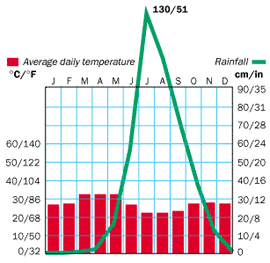 CLIMATE CLIMATE |

Climatically all of Guinea shares two alternating seasons: a dry season (November to March) and a wet season (April to October). Rainfall varies from region to region with as much as 170 inches per year at Conakry on the coast to less than sixty inches a year in Upper Guinea. The rainfall in Middle Guinea ranges from 63 to 91 inches per year while some areas in the Forest Region have more than 100 inches of rain per year. Temperature ranges also vary according to the different regions. On the coast and in the Forest Region the temperature ranges around an average of 81 degrees Fahrenheit.
| The Fouta highland of Middle Guinea may experience January daytime temperatures of 86 to 95 degrees Fahrenheit while nighttime temperatures may dip below 50 degrees Fahrenheit. Mid-day highs of more than 100 degrees Fahrenheit are not uncommon in Upper Guinea during the dry season.
Top 10 wettest cities in the world:
Mean Annual Rainfall, inches | | 1 | Buenaventura, Columbia | 265.47 | | 2 | Monrovia, Liberia | 202.01 | | 3 | Pago Pago, American Samoa | 196.46 | | 4 | Moulmein, Burma | 191.02 | | 5 | Lae, Papua New Guinea | 182.87 | | 6 | Baguio, Philippines | 180.04 | | 7 | Sylhet, Bangladesh | 175.47 | | 8 | Conakry, Guinea | 170.91 | | 9 | Padang, Indonesia | 166.34 | | 10 | Bogor, Indonesia | 166.33 |
|

